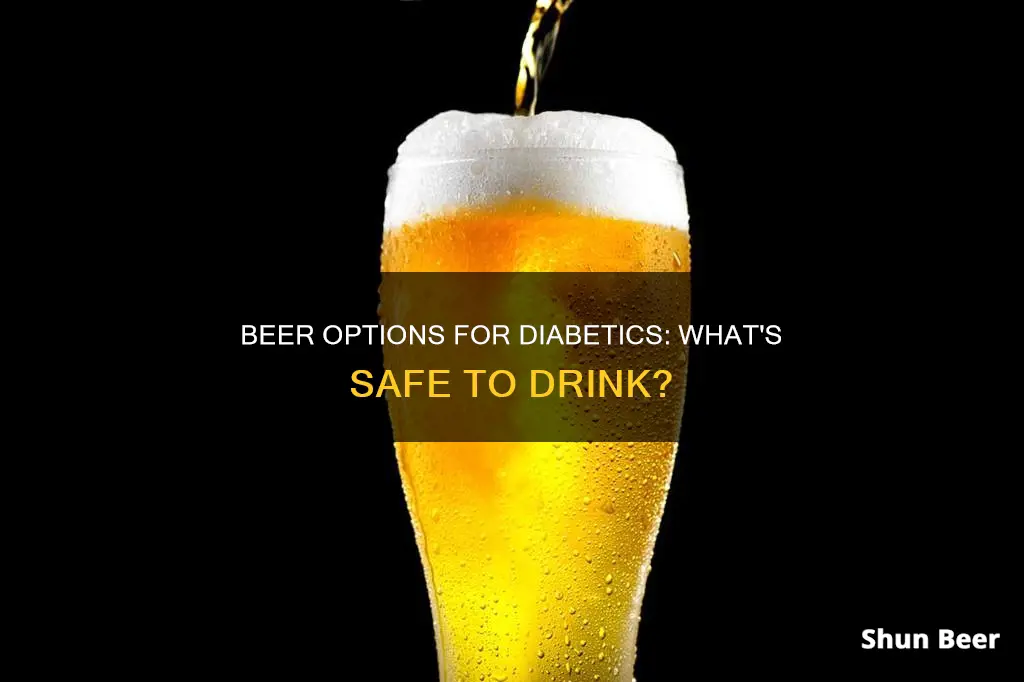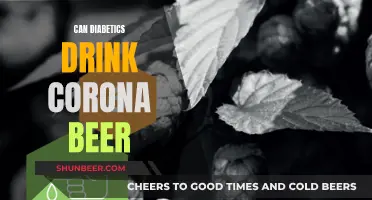
People with diabetes don't need to cut alcohol out of their lives completely, but they do need to be mindful of how it can affect their body and how to manage this. Beer is a significant source of carbohydrates, so it can impact blood sugar. Depending on the type, it can also be high in calories, so drinking beer may contribute to weight gain over time. Some types of beer can be higher in alcohol, too. According to the ADA, drinking alcohol can slow down carb metabolism, potentially leading to low blood sugar (hypoglycemia). So, it's essential to be mindful when consuming beer when you have diabetes.
What You'll Learn

Diabetics can drink beer in moderation
People with diabetes can still enjoy a beer, but it's important to be mindful of how it can affect your body and how to manage this. It's not necessary to cut alcohol out of your diet, but there are some safety considerations to keep in mind.
Alcohol and Diabetes
Drinking alcohol may affect your blood sugar levels, interact with diabetes medications, and contribute to complications. However, drinking a moderate amount of certain types of alcohol may be safer. Alcohol competes with your liver's ability to make glucose when your blood sugar is low, which can lead to dangerously low blood sugar levels. This effect can last up to 24 hours after you stop drinking.
The general alcohol consumption recommendation is the same for people with diabetes as it is for the general population: no more than one drink per day for women and up to two drinks per day for men. Binge drinking is strongly discouraged for health and safety reasons. If you're at a sporting event and plan to drink over several hours, it's important to pace yourself and not overindulge. As a rule of thumb, try to stick to no more than one drink per hour and no more than three or four drinks for the day.
Beer and Carbohydrates
Beer is typically higher in carbohydrates than other alcoholic drinks like wine or liquor. The carb content of beers can vary widely depending on the type of beer. "Light" beers tend to have the least amount of carbohydrates, usually five grams or fewer per serving. They are also lower in alcohol content. If you're going to have more than one beer, it's best to stick with light beers. Hoppy craft beers like IPAs and stouts tend to be much higher in carbs, usually 15 grams or more per serving. They're also higher in calories and alcohol, so it's recommended to stick to just one serving.
Preventing Hypoglycemia
To prevent hypoglycemia, it's important to not drink on an empty stomach. Make sure you have food with your drink and keep an eye on your blood sugar levels. It's also a good idea to let your friends know that you have diabetes and that hypoglycemia has similar symptoms to being drunk, such as dizziness, confusion, and lightheadedness. They can help keep an eye on you and get you help if your blood sugar drops too low.
Drinking 20 Beers: A Night to Remember or Forget?
You may want to see also

Beer impacts blood sugar levels
Beer can impact blood sugar levels, so it's important to know how to drink it safely if you have diabetes. Beer is a significant source of carbohydrates, and its impact on blood sugar levels can vary depending on the type of beer.
How Beer Impacts Blood Sugar Levels
When you have diabetes, your body struggles to get sugar into your bloodstream for your cells to utilise. This can lead to hyperglycaemia, where there is too much sugar in the blood, which can damage organs and body tissues. Drinking beer, which contains carbohydrates, can cause a spike in blood sugar levels. However, the impact of beer on blood sugar levels is twofold. Beer can also cause hypoglycaemia, or low blood sugar, because the liver, where glucose is stored, is busy clearing alcohol from your system, which may delay the release of necessary sugars into the bloodstream.
Preventing Hypoglycaemia
To prevent hypoglycaemia when drinking beer, it is important not to drink on an empty stomach. Eating a balanced meal with protein, fibre, and healthy fats will slow the absorption of alcohol into your system, keeping blood sugar levels more stable. It is also important to monitor your blood sugar levels before, during, and up to 24 hours after drinking. The risk of hypoglycaemia increases after drinking and can last for up to 24 hours. Staying within a blood sugar safe zone of 70-180 mg/dL is important. Before bed, your blood sugar should be between 100-140 mg/dL. If your reading is below this, have a snack with carbs and protein to bring it up.
Choosing the Right Beer
When choosing a beer, opt for "light" beers, which have the fewest carbs, usually five or fewer grams per serving. They are also lower in alcohol content. Beers with lower alcohol by volume (ABV) will have closer to six grams of carbs, while higher ABV beers may have 20-30 grams of carbs per 12-ounce bottle. If you are drinking beer on tap and don't have access to nutrition facts, selecting beers with an ABV of 7% or less can help keep your carb intake in check. Some examples of lower-carb beers include Corona Premier, Michelob Ultra, and Coors Light.
Serving Size Matters
It is important to be mindful of serving sizes when drinking beer. The general alcohol consumption recommendation is no more than one drink per day for women and up to two drinks per day for men. For beer, one drink is considered 12 ounces. It is easy to exceed this amount when drinking from a pint glass, which holds 16 ounces. Pacing yourself is crucial, and it is recommended to have no more than one drink per hour and no more than three or four drinks per day.
Other Considerations
If you take insulin or other diabetes medications, drinking alcohol can lead to dangerously low blood sugar levels up to 24 hours after drinking. Alcohol can also cloud your judgment, so you may not realise your blood sugar is low. It is important to be aware of the symptoms of hypoglycaemia, which include dizziness, confusion, and lightheadedness, as they can be similar to the symptoms of intoxication. Letting your friends know about your diabetes and these symptoms can help them keep you safe if your blood sugar drops too low.
In summary, people with diabetes can usually drink beer safely, but it is important to be mindful of how it can impact blood sugar levels. Choosing the right type of beer, monitoring serving sizes, and being cautious of the risks associated with alcohol and diabetes can help ensure a safe and enjoyable drinking experience.
Pregnant Women and Root Beer: Is It Safe?
You may want to see also

Alcohol competes with the liver's ability to make glucose
Alcohol can affect the liver's ability to produce glucose, which can lead to dangerously low blood sugar levels. This is particularly true for people with diabetes who are taking insulin or other anti-hyperglycemic medications. When blood sugar is low, the liver's primary function is to release stored glucose into the bloodstream to stabilise blood sugar levels. However, when alcohol is present in the body, the liver prioritises metabolising and breaking down the alcohol instead of maintaining blood sugar levels. This can lead to a dangerous condition called hypoglycaemia, where blood sugar levels drop too low. The risk of hypoglycaemia is further increased if drinking alcohol on an empty stomach, as food helps to slow down the absorption of alcohol, giving the liver more time to regulate blood sugar levels.
The symptoms of hypoglycaemia, such as slurred speech, drowsiness, confusion, and difficulty walking, can be similar to the symptoms of being drunk, making it difficult to distinguish between the two conditions. Additionally, the effects of alcohol can cloud judgement, making it harder to recognise the warning signs of low blood sugar. The risk of hypoglycaemia can last for several hours after drinking, and even occur during sleep, so it is important for people with diabetes to monitor their blood sugar levels regularly when consuming alcohol and to consume food along with alcoholic beverages.
It is important to note that the effects of alcohol on the liver's ability to produce glucose are not limited to people with diabetes. Anyone who consumes excessive amounts of alcohol may experience hypoglycaemia, especially if drinking on an empty stomach. However, the risk may be higher for people with diabetes, especially if they are taking medications that affect blood sugar levels. Therefore, it is crucial for people with diabetes to be aware of the potential risks associated with alcohol consumption and to drink in moderation, following the recommended guidelines for safe alcohol consumption.
Drinking Beer in Public: Vietnam's Laws and Culture
You may want to see also

Beer is a source of carbohydrates
Beer is a significant source of carbohydrates, with an average 12-ounce can containing 13 grams of carbohydrates. The number of carbs in beer varies depending on the type, with "light" beers containing the least amount of carbs, usually five grams or fewer per serving. Hoppy craft beers like IPAs and stouts tend to be much higher in carbs, typically 15 grams or more per serving. Beers with lower alcohol by volume (ABV) tend to have fewer carbs, with those under 7% ABV containing around six grams of carbs, while higher ABV beers may have 20-30 grams of carbs per 12-ounce bottle.
The American Diabetes Association (ADA) recommends that women have no more than one drink per day, and men limit themselves to no more than two drinks per day. For beer, one drink is considered to be 12 ounces. It is important for people with diabetes to be mindful of their alcohol consumption, as it can affect their blood sugar levels and interact with diabetes medications. Alcohol competes with the liver's ability to produce glucose, which can lead to dangerously low blood sugar levels, especially if drinking on an empty stomach.
To prevent hypoglycemia, it is recommended to drink in moderation, eat before and during drinking, and monitor blood sugar levels regularly. Additionally, choosing light beers, pacing yourself, and staying hydrated are important considerations for people with diabetes who want to enjoy a beer.
While beer is a source of carbohydrates, it is not the only factor to consider when it comes to blood sugar management. The alcohol content and serving size also play a role in how beer affects blood sugar levels. It is important for people with diabetes to be mindful of their overall alcohol consumption and to follow the recommendations of their healthcare providers.
Beer Fast: Does It Work Quickly?
You may want to see also

Diabetics should not drink on an empty stomach
For people with diabetes, drinking alcohol can be safe, but it is important to choose the right types of drinks and consider the effects on blood sugar levels. Diabetes causes lower-than-normal production or function of insulin, the hormone that controls blood sugar levels, so blood sugar management is crucial. Alcohol consumption can cause blood sugar levels to rise or fall, depending on the drink and whether food has been consumed recently.
Drinking on an empty stomach is not recommended for diabetics as it can lead to hypoglycemia, or dangerously low blood sugar levels. This is because the liver, which stores and releases glucose, is also responsible for clearing alcohol from the body. When you drink, your body prioritises getting rid of the alcohol, which can interrupt blood sugar regulation. Eating a balanced meal with protein, fibre, and healthy fats before drinking slows the absorption of alcohol in the body, keeping blood sugar levels more stable.
To prevent hypoglycemia, it is important for diabetics to avoid drinking on an empty stomach and to monitor their blood sugar levels regularly before, during, and after drinking, and even up to 24 hours afterward. Additionally, staying hydrated by drinking water with alcoholic beverages is recommended.
The effects of alcohol on blood sugar levels can be dangerous for diabetics, especially when combined with certain medications. Alcohol can interfere with the liver's ability to produce glucose, and this effect is more pronounced when blood sugar levels are already low. As a result, drinking on an empty stomach can further decrease blood sugar levels and lead to hypoglycemia.
Furthermore, drinking on an empty stomach can increase the risk of a hypo, which is when blood sugar levels drop too low. This is particularly important for people with diabetes who use insulin or other diabetes medications, as alcohol can enhance the risk of hypoglycemia. The symptoms of hypoglycemia can also mimic those of intoxication, such as drowsiness, confusion, or difficulty walking, making it challenging to distinguish between the two. Therefore, it is crucial for diabetics to avoid drinking on an empty stomach and to monitor their blood sugar levels closely.
In conclusion, while diabetics can safely consume alcohol in moderation, it is important to avoid drinking on an empty stomach. By following this guideline and monitoring blood sugar levels, diabetics can reduce the risk of hypoglycemia and effectively manage their blood sugar levels while enjoying alcoholic beverages.
Non-Alcoholic Beer: Safe for Liver Disease Patients?
You may want to see also
Frequently asked questions
Yes, diabetics can drink beer, but it's important to do so in moderation and to be aware of how it can affect your body. Beer is a significant source of carbohydrates, so it can impact blood sugar. It can also be high in calories and alcohol content.
According to experts, people with diabetes should select the lightest beer on the market, with an alcohol content of under 4% being ideal. Examples include Corona Premier, Michelob Ultra, and Coors Light.
Beer contains carbohydrates that can cause blood sugar to spike and then fall quickly, potentially leading to hypoglycemia or low blood sugar. Additionally, drinking alcohol can interrupt blood sugar regulation as the liver prioritises clearing alcohol from the body over releasing glucose into the bloodstream.







